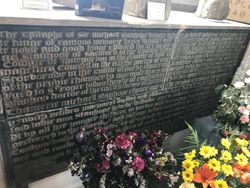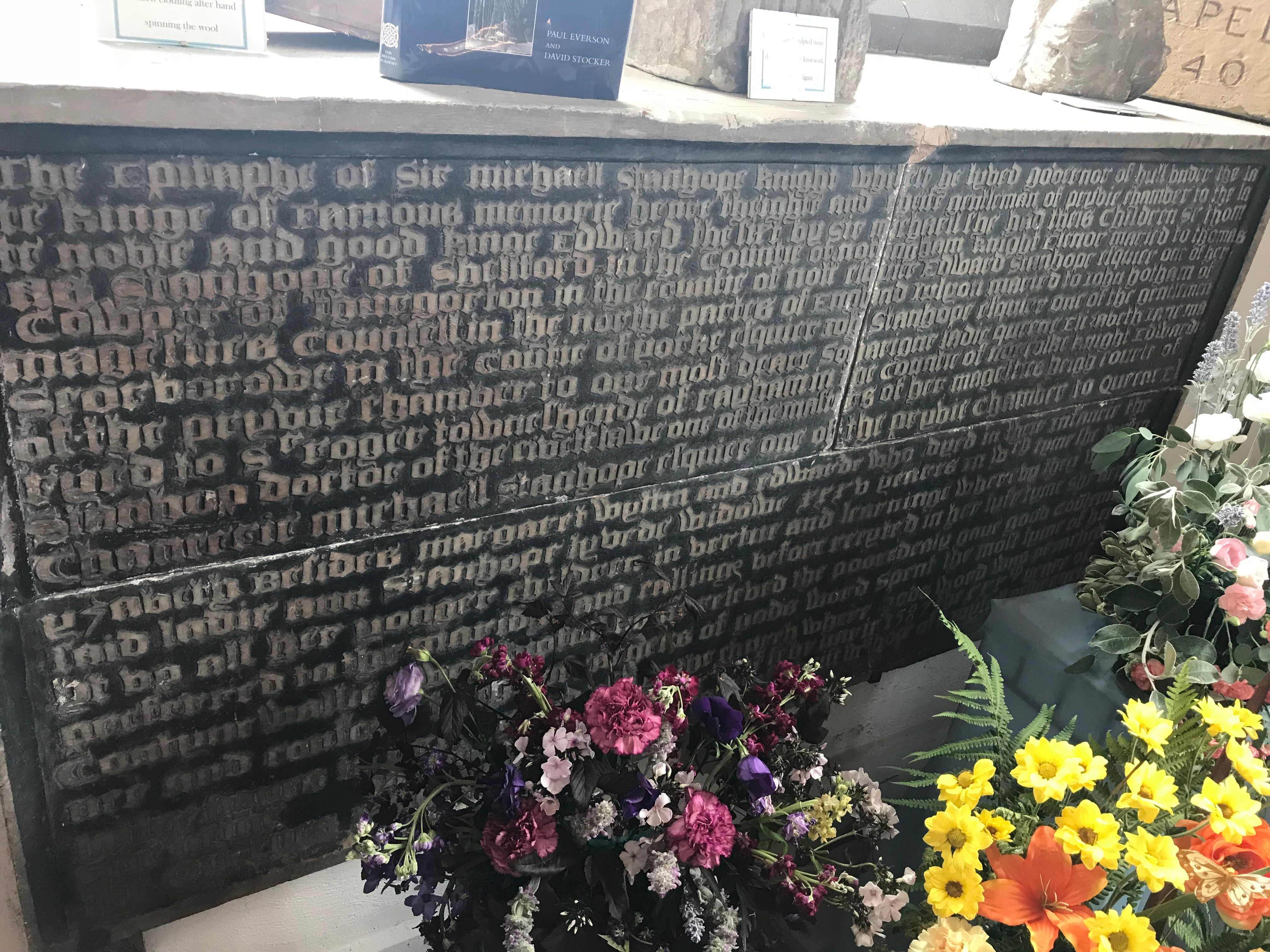In 1546 he was dubbed a Knight at Hampton Court, and in the following year he received the appointment of Governor of Hull. In 1548 he was chosen Chief Gentleman of the Privy Chamber to King Edward VI. The high responsible position to which he had now attained brought with it grave results. The rivalry and jealousy the existed among those who held high places among the King's Councillors, made it extremely hazardous in those days to occupy exalted positions, especially as taking the life of a person who stood in the way of the promotion of another, seems to have been comparatively easily arranged for, on the ground that the success or wellbeing of the Government demanded it. Thus the flattering career of our noble Knight was soon to reach a close. Sir Edward Stanhope, the father of Sir Michael, was twice married. . . . After the death of Michael's mother, he married Elizabeth, daughter of Fulc Bourchier, Lord Fitz Warin, by whom he had a daughter Anne, who became the wife of Edward Seymour, Duke of Somerset, who was uncle as well as Protector to King Edward VI. Through the belief that his brother Thomas (Lord Seymour,) had been intriguing against him, the Protector had him arrested, tried for treason, condemned, and beheaded on the 20th of March, 1549. But soon the tables were turned. A powerful rival to the Duke of Somerset appeared in the person of John Dudley, Earl of Warwick and Duke of Northumberland, who had been compelled to resign the office of Lord High Admiral by the Protector, in order that his brother, Thomas Seymour, might receive that appointment, and was only waiting for an opportunity to get his revenge. Dudley had again been made Lord High Admiral, and soon succeeded in gaining extensive influence among the Lords of the Council, and was in especial favor with the King. So skillful was he in conducting his efforts that he finally succeeded in influencing the King to sign the deposition of his Uncle the Protector, and on the 14th of October, 1551, he, with the Duchess and several other persons, quite likely Sir Michael Stanhope among the number, were sent as prisoners to the Tower. On it appearing that the life of the Duke of Northumberland was in danger, the King allowed the law to take its course. The Protector and his brother-in-law, Sir Michael Stanhope were tried and condemned to death, the Duke of Somerset being beheaded on Friday, the 22nd day of January, 1552, Sir Michael sharing the same fate on the 26th day of the month following. . . .
Anne . . . (and) Michael Stanhope . . .(had) eleven children . . . . Thomas, the eldest, was Knighted at Kenilworth in the year 1575. He married Margaret, the daughter of Sir John Port, by whom he had Sir John, who was the father of Philip Stanhope, first Earl of Chesterfield.
On the death of Richard, who died without issue, his brother Michael became chief of the family, and obtained from King Henry VIII, in the year 1538, a grant of Eveshall Forest, and of the house and site of the monastery of Shelford, in the same county, the almshouse, &c., within it, and other lands thereunto belonging; also the manor of Shelford with its members, parcel of the possessions of the dissolved monastery there, with several rectories in the counties of Nottingham, Lincoln and Derby. In 1544, he was constituted the king's steward of the great lordship of Holderness and Cottingharn in the county of York. Two years later he was knighted by the king, and appointed Governor of Hull. In 1547 he became chief gentleman of the privy chamber, and one of the knights of the shire for the county of Nottingham. But in 1551, without any reason alleged, he was committed prisoner to the Tower with the Duke of Somerset, the Duke's wife, Anne, being his half-sister, and the relationship being thought sufficient ground for concluding him guilty. Accordingly, when the Duke was released, Sir Michael was also given his liberty without accusation. Two years afterwards however, he was again imprisoned with the Duke and Duchess, tried, and it is said on the evidence of one Crane, was found guilty of conspiring the death of a privy councillor, and sentenced to die ; and was beheaded on Tower Hill, about a month after the Duke of Somerset had suffered the same penalty, Sir Michael protesting his innocence to the last, in the most solemn manner. William Playfair, Esq., in his elaborate work entitled British Family Antiquity, shows with a considerable degree of success that Somerset was blameless of the charges made against him, and says if the Duke was blameless 'it is still more evident that Stanhope was so.'"
[Crane, Ellery Bicknell, _Ancestry of Edward Rawson_, 1887]
In 1546 he was dubbed a Knight at Hampton Court, and in the following year he received the appointment of Governor of Hull. In 1548 he was chosen Chief Gentleman of the Privy Chamber to King Edward VI. The high responsible position to which he had now attained brought with it grave results. The rivalry and jealousy the existed among those who held high places among the King's Councillors, made it extremely hazardous in those days to occupy exalted positions, especially as taking the life of a person who stood in the way of the promotion of another, seems to have been comparatively easily arranged for, on the ground that the success or wellbeing of the Government demanded it. Thus the flattering career of our noble Knight was soon to reach a close. Sir Edward Stanhope, the father of Sir Michael, was twice married. . . . After the death of Michael's mother, he married Elizabeth, daughter of Fulc Bourchier, Lord Fitz Warin, by whom he had a daughter Anne, who became the wife of Edward Seymour, Duke of Somerset, who was uncle as well as Protector to King Edward VI. Through the belief that his brother Thomas (Lord Seymour,) had been intriguing against him, the Protector had him arrested, tried for treason, condemned, and beheaded on the 20th of March, 1549. But soon the tables were turned. A powerful rival to the Duke of Somerset appeared in the person of John Dudley, Earl of Warwick and Duke of Northumberland, who had been compelled to resign the office of Lord High Admiral by the Protector, in order that his brother, Thomas Seymour, might receive that appointment, and was only waiting for an opportunity to get his revenge. Dudley had again been made Lord High Admiral, and soon succeeded in gaining extensive influence among the Lords of the Council, and was in especial favor with the King. So skillful was he in conducting his efforts that he finally succeeded in influencing the King to sign the deposition of his Uncle the Protector, and on the 14th of October, 1551, he, with the Duchess and several other persons, quite likely Sir Michael Stanhope among the number, were sent as prisoners to the Tower. On it appearing that the life of the Duke of Northumberland was in danger, the King allowed the law to take its course. The Protector and his brother-in-law, Sir Michael Stanhope were tried and condemned to death, the Duke of Somerset being beheaded on Friday, the 22nd day of January, 1552, Sir Michael sharing the same fate on the 26th day of the month following. . . .
Anne . . . (and) Michael Stanhope . . .(had) eleven children . . . . Thomas, the eldest, was Knighted at Kenilworth in the year 1575. He married Margaret, the daughter of Sir John Port, by whom he had Sir John, who was the father of Philip Stanhope, first Earl of Chesterfield.
On the death of Richard, who died without issue, his brother Michael became chief of the family, and obtained from King Henry VIII, in the year 1538, a grant of Eveshall Forest, and of the house and site of the monastery of Shelford, in the same county, the almshouse, &c., within it, and other lands thereunto belonging; also the manor of Shelford with its members, parcel of the possessions of the dissolved monastery there, with several rectories in the counties of Nottingham, Lincoln and Derby. In 1544, he was constituted the king's steward of the great lordship of Holderness and Cottingharn in the county of York. Two years later he was knighted by the king, and appointed Governor of Hull. In 1547 he became chief gentleman of the privy chamber, and one of the knights of the shire for the county of Nottingham. But in 1551, without any reason alleged, he was committed prisoner to the Tower with the Duke of Somerset, the Duke's wife, Anne, being his half-sister, and the relationship being thought sufficient ground for concluding him guilty. Accordingly, when the Duke was released, Sir Michael was also given his liberty without accusation. Two years afterwards however, he was again imprisoned with the Duke and Duchess, tried, and it is said on the evidence of one Crane, was found guilty of conspiring the death of a privy councillor, and sentenced to die ; and was beheaded on Tower Hill, about a month after the Duke of Somerset had suffered the same penalty, Sir Michael protesting his innocence to the last, in the most solemn manner. William Playfair, Esq., in his elaborate work entitled British Family Antiquity, shows with a considerable degree of success that Somerset was blameless of the charges made against him, and says if the Duke was blameless 'it is still more evident that Stanhope was so.'"
[Crane, Ellery Bicknell, _Ancestry of Edward Rawson_, 1887]
Inscription
The epitaphe of Sir Michael Stanhope. Kit. Whilst he lived, Governor of Hull, under the
late King of famous memory, Henry 8, and chief gentleman of the Privy Chamber to the late
Noble and good King Edw. 6. By Sir Michael she had these children;- Sir Thomas Stanhope, of
Shelford, in the County of Nott: Knight; Eleanor married to Thomas Cooper, of Thurgarton,
in Com: Nott: Esq. Edward Stanhope Esq. one of his Majesties Council in the North Parts
of England; Julian married to John Hotham of Scoreborough in Com Eborum Esquire; Edward
Stanhope Doctor of the Civil Law one of her Majesties High Court of Chancery; Michaell
Stanhope Esquire one of the Privy Chamber to Queen Elizabeth; besides Margaret, William
and Edward who died in their infancy. The said Lady Anne Stanhope lived wydow thirty-five
Years in which time she brought up all the younger children in vertue and learning whereby
they were preferred to the marriage and calling before recited in her life time. She kept con-
tinually a worshipful house, relieved the poor daily, gave good countenance and comfort to the
Preachers of God's Word; spent the most of the time of her latter daies in Prayer and using
the Church where God's Word was preached. She being _ _ old she died 20th day of Febru-
ary anno 1587 in the thirtieth year of the Reign aforesaid in the Faith of Christ with hope of a
joyful Resurrection.
Family Members
Advertisement
Explore more
Sponsored by Ancestry
Advertisement








